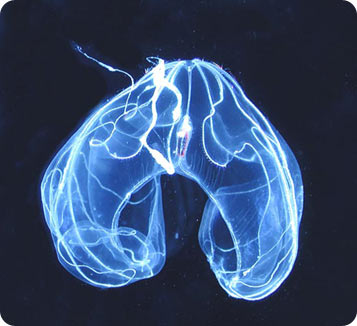Over the last decade, marine scientists have been busily counting the organisms in the oceans. And not surprisingly, they just don’t have enough fingers and toes to add them all up. They’ve already announced thousands of possible new species, and should add many more to the list when they report on the Census of Marine Life this fall.
 An example of a comb jelly. Credit: Arctic Exploration 2002, Marsh Youngbluth, NOAA/OER
An example of a comb jelly. Credit: Arctic Exploration 2002, Marsh Youngbluth, NOAA/OERThe list of possible new species includes jellyfish, sponges, shrimp, crabs, and many others. One example is a relative of the jellyfish known as a comb jelly.
Around a hundred species of comb jelly were already known all around the world. Like a jellyfish, a comb jelly has a jelly-like body and a set of tentacles. But unlike a jellyfish, it swims using hair-like structures that look like the teeth of a comb, and it doesn’t sting.
An expedition in the western Pacific, off the coast of Japan, discovered a new species of comb jelly in 2002. Not only had this species never been seen before, but no species had ever been seen at these kinds of depths: more than three miles down.
The new species anchors two long thread-like filaments in the seafloor. Its body then rides the current like a kite. It uses two long tentacles to snatch prey.
The discovery was surprising because marine biologists didn’t think there would be enough for the jellies to eat at such great depths. So researchers will need to look more carefully to see just what the comb jellies are eating -- a census of marine life that could discover even more new species in the deep ocean.

